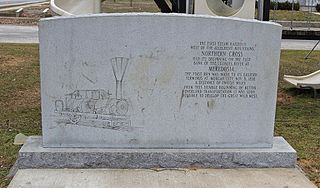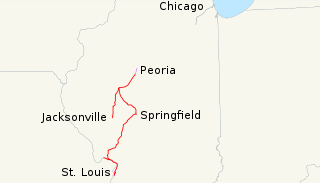
Gilman is a city in Douglas Township, Iroquois County, Illinois, United States. The population was 1,814 at the 2010 census.

Clinton is a city in, and the county seat of, Clinton County, Iowa, United States. The population was 26,885 as of 2010. Clinton, along with DeWitt, was named in honor of the sixth governor of New York, DeWitt Clinton. Clinton is the principal city of the Clinton Micropolitan Statistical Area, which is coterminous with Clinton County. Clinton was incorporated on January 26, 1857.

Charles Morgan was an American railroad and shipping magnate. He played a leading role in the development of transportation and commerce in the Southern United States through the mid- to late-19th century.

The Illinois Central Railroad, sometimes called the Main Line of Mid-America, was a railroad in the central United States, with its primary routes connecting Chicago, Illinois, with New Orleans, Louisiana, and Mobile, Alabama. A line also connected Chicago with Sioux City, Iowa (1870). There was a significant branch to Omaha, Nebraska (1899), west of Fort Dodge, Iowa, and another branch reaching Sioux Falls, South Dakota (1877), starting from Cherokee, Iowa. The Sioux Falls branch has been abandoned in its entirety.

The Boston and Albany Railroad was a railroad connecting Boston, Massachusetts to Albany, New York, later becoming part of the New York Central Railroad system, Conrail, and CSX Transportation. The line is currently used by CSX for freight. Passenger service is still provided on the line by Amtrak, as part of their Lake Shore Limited service, and by the MBTA Commuter Rail system, which owns the section east of Worcester and operates it as its Framingham/Worcester Line.

The New York and New England Railroad was a major railroad connecting southern New York State with Hartford, Connecticut, Providence, Rhode Island, and Boston, Massachusetts. It operated under that name from 1873 to 1893. Prior to 1873 it was known as the Boston, Hartford and Erie Railroad, which had been formed by several smaller railroads dating back to 1846. After bankruptcy in 1893, the New York and New England Railroad was reorganized and became known as the New England Railroad before its 1898 lease to the competing New York, New Haven and Hartford Railroad. Today, most of the original New York and New England lines have been abandoned; however a portion in Massachusetts is now part of the MBTA's Franklin Line providing commuter rail service to South Station in Boston. The Connecticut Southern Railroad operates freight service on a small portion of the former NY&NE line near East Hartford and Manchester, Connecticut. Other portions in Connecticut and Rhode Island have been converted to rail trails.

The Central Massachusetts Railroad was a railroad in Massachusetts. The eastern terminus of the line was at North Cambridge Junction where it split off from the Middlesex Central Branch of the Boston and Lowell Railroad in North Cambridge and through which it had access to North Station in Boston. From there, the route ran 98.77 miles west through the modern-day towns of Belmont, Waltham, Weston, Wayland, Sudbury, Hudson, Bolton, Berlin, Clinton, West Boylston, Holden, Rutland, Oakham, Barre, New Braintree, Hardwick, Ware, Palmer, Belchertown, Amherst, and Hadley to its western terminal junction at N. O. Tower in Northampton with the Connecticut River Railroad.

Central Station was an intercity passenger terminal in downtown Chicago, Illinois, at the southern end of Grant Park near Roosevelt Road and Michigan Avenue. Owned by the Illinois Central Railroad, it also served other companies via trackage rights. It opened in 1893, replacing Great Central Station, and closed in 1972 when Amtrak rerouted services to Union Station. The station building was demolished in 1974. It is now the site of a redevelopment called Central Station, Chicago.
The National Railway or National Air Line Railroad was a planned railroad between New York City and Washington, D.C. in the United States around 1870. Part of it was eventually built from New York to Philadelphia by the Delaware and Bound Brook Railroad and the Delaware River Branch of the North Pennsylvania Railroad, leased by the Philadelphia and Reading Railway in 1879 and becoming its New York Branch. The line was intended to provide an alternate to the various monopolies that existed along the route, specifically the United New Jersey Railroad and Canal Companies and their Camden and Amboy Railroad, and as such had a long struggle to be built.
The New London Northern Railroad was a part of the Central Vermont Railway from New London, Connecticut, north to Brattleboro, Vermont. After a long period with the Canadian National Railway, it is now operated by the New England Central Railroad. The New London Northern was the only through railroad in Connecticut not to come under the control of the New York, New Haven and Hartford Railroad.

The Pittsburgh, Cincinnati, Chicago and St. Louis Railroad, commonly called the Pan Handle Route, was a railroad that was part of the Pennsylvania Railroad system. Its common name came from its main line, which began at Pittsburgh, Pennsylvania, crossed the Northern Panhandle of West Virginia, and continued west to Bradford, Ohio, where it split into a northern line to Chicago and a southern one through Indianapolis, Indiana, to East St. Louis, Illinois.

The Alton Railroad was the final name of a railroad linking Chicago to Alton, Illinois; St. Louis, Missouri; and Kansas City, Missouri. Its predecessor, the Chicago and Alton Railroad, was purchased by the Baltimore and Ohio Railroad in 1931 and was controlled until 1942 when the Alton was released to the courts. On May 31, 1947, the Alton Railroad was merged into the Gulf, Mobile and Ohio Railroad. Jacob Bunn had been one of the founding reorganizers of the Chicago & Alton Railroad Company during the 1860s.

Chestnut is a census-designated place in Aetna Township, Logan County, Illinois. As of the 2010 census, its population was 246. The community is located northwest across the railroad tracks along Illinois Route 54 at Dauphin Street. Its claim to fame, for the sake of town promotion, is that it is the geographic center of the state. A small monument to this effect has been erected in a park near the southwest corner of Melvin Street and East Olive street. However, the exact center of Illinois is about eight miles southwest of Chestnut, and on the other side of the town of Mount Pulaski, at 89°18.4'W 40°0.8'N.
The South Side Railroad of Long Island was a railroad company in the U.S. state of New York. Chartered in 1860 and first opened in 1867 as a competitor to the Long Island Rail Road, it was reorganized in 1874 as the Southern Railroad of Long Island and leased in 1876 to the LIRR. After a reorganization as the Brooklyn and Montauk Railroad in 1879 it was merged in 1889.

Springfield Union Station in Springfield, Illinois, is a former train station and now part of the complex of buildings that together form the Abraham Lincoln Presidential Library and Museum. It is listed on the National Register of Historic Places, and is located at 500 East Madison Street in downtown Springfield, adjacent to the Lincoln Presidential Library.

The Northern Cross Railroad was the first railroad to operate in Illinois, originating in Meredosia and eventually extending both east and west to the state borders. It eventually linked the state capital Springfield east to Decatur and Danville, and west to Jacksonville and the Illinois River, and later to Quincy on the Mississippi River.
The Hartford and New Haven Railroad (H&NH) was an important direct predecessor of the New York, New Haven and Hartford Railroad. Its railroad commenced service in 1844 and ended independent operations in 1872. The main line from New Haven, Connecticut to Springfield, Massachusetts remains in Amtrak service.

The Chicago, Peoria and St. Louis Railroad (CP&StL) was a railroad in the U.S. state of Illinois that operated a main line between Pekin and Madison via Springfield. Its property was sold at foreclosure to several new companies in the 1920s; the portion north of Springfield has since become the Illinois and Midland Railroad, while the remainder has been abandoned, except for a portion near St. Louis that is now owned by the Norfolk Southern Railway.
The Chicago and Illinois River Railroad was a predecessor of the Alton Railroad that built a line from Joliet southwest through Coal City, Illinois, to the Mazon River. A portion is now a second main track on the BNSF Railway's Southern Transcon.

The Green Diamond was a streamlined passenger train operated by the Illinois Central Railroad between Chicago, Illinois and St. Louis, Missouri. It operated from 1936 until 1968. It was the Illinois Central's first streamliner. Initially it operated with Illinois Central 121, the last of the 1930s fixed-consist articulated streamliners built in the United States. After 1947 it operated with more conventional streamlined equipment until its discontinuance. The name honored the "green diamond" in the Illinois Central's logo as well as the Diamond Special, the Illinois Central's oldest train on the Chicago-St. Louis run.















